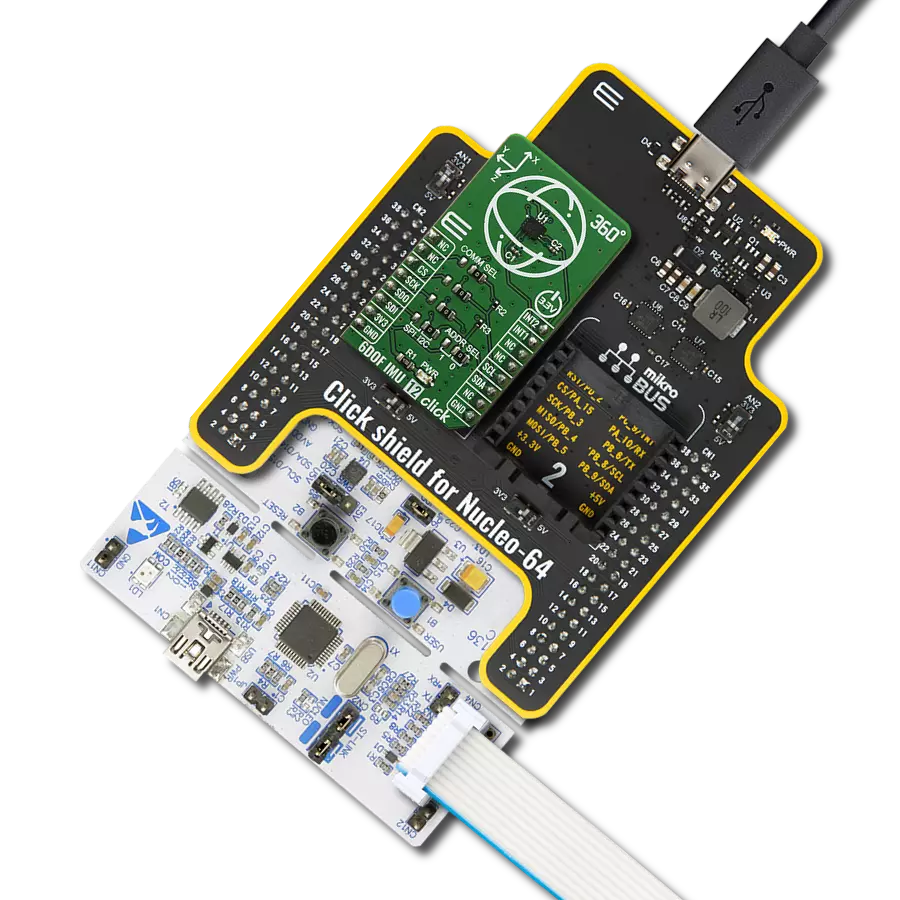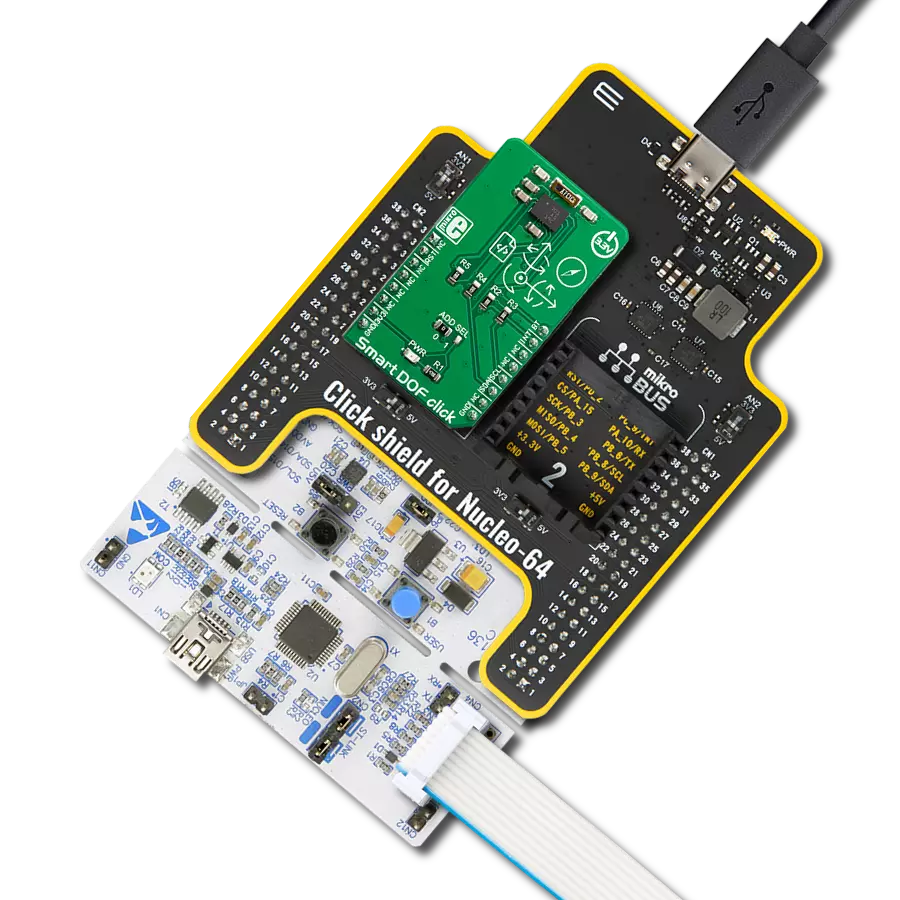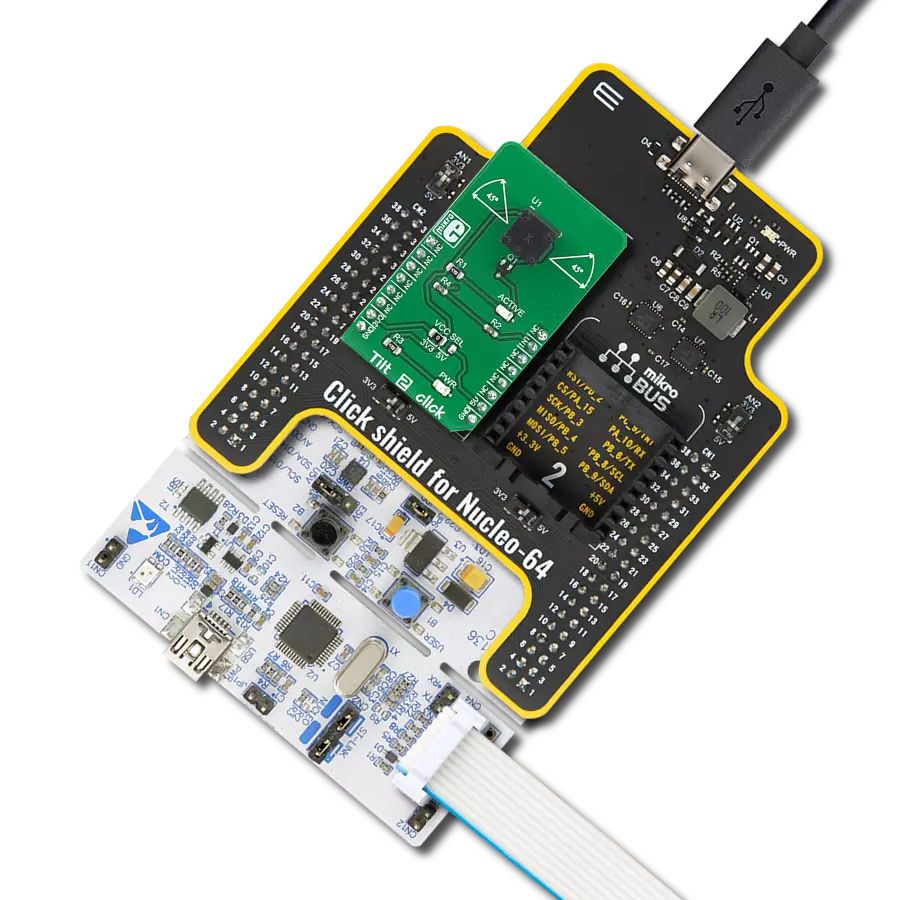Detect intruders or unauthorized access for commercial security systems, or enable motion-based home automation for various devices and systems
A
A
Hardware Overview
How does it work?
PIR 3 Click is based on the ZDP323B1, a dual-element balanced differential pyroelectric (PIR) sensor from Zilog (Littelfuse). Designed for high performance and excellent EMI immunity, this sensor is ideal for demanding motion detection applications such as security/intrusion motion detectors, lighting control, video doorbells, and many more. The ZDP323B1 features a low-profile surface mount package compatible with IR reflow processes. It includes two sensing elements behind a spectral filter window tuned to an 8-13um wavelength, blocking unwanted IR energy sources. With a 0.6mm element spacing (elements are 0.75mm x 2.3mm spaced 0.6mm apart), it provides additional white light protection and a typical field of view of 148 degrees from the center of the element on the X-axis and 136 degrees on the Y-axis. Combined with the ZDP323B1, the PIR 3 Click also integrates the ZNCL10S PIR lens made
from high-density polyethylene. This lens ensures maximum IR transmissivity with well-defined beam patterns. It clips directly into the Click board™ over the ZDP323B1 sensor, simplifying mechanical design. This Click board™ is designed in a unique format supporting the newly introduced MIKROE feature called "Click Snap." Unlike the standardized version of Click boards, this feature allows the main sensor area to become movable by breaking the PCB, opening up many new possibilities for implementation. Thanks to the Snap feature, the ZDP323B1 can operate autonomously by accessing its signals directly on the pins marked 1-8. Additionally, the Snap part includes a specified and fixed screw hole position, enabling users to secure the Snap board in their desired location. PIR 3 Click uses a standard 2-wire I2C interface to communicate with the host MCU, supporting Standard mode with up to 400kHz of frequency
clock. The I2C interface and registers allow for controlling various sensor functions, such as programmable gain, bandwidth, and detection thresholds. This flexibility ensures precise and customizable operations tailored to specific application needs. In addition, the SDA signal can also be used as a motion trigger output to interrupt or wake up a host MCU when motion is detected. This Click board™ can operate with either 3.3V or 5V logic voltage levels selected via the VCC SEL jumper and activated via the ON pin of the mikroBUS™ socket, providing a power-enable function. This way, both 3.3V and 5V capable MCUs can use the communication lines properly. Also, this Click board™ comes equipped with a library containing easy-to-use functions and an example code that can be used as a reference for further development.
Features overview
Development board
Nucleo 32 with STM32F031K6 MCU board provides an affordable and flexible platform for experimenting with STM32 microcontrollers in 32-pin packages. Featuring Arduino™ Nano connectivity, it allows easy expansion with specialized shields, while being mbed-enabled for seamless integration with online resources. The
board includes an on-board ST-LINK/V2-1 debugger/programmer, supporting USB reenumeration with three interfaces: Virtual Com port, mass storage, and debug port. It offers a flexible power supply through either USB VBUS or an external source. Additionally, it includes three LEDs (LD1 for USB communication, LD2 for power,
and LD3 as a user LED) and a reset push button. The STM32 Nucleo-32 board is supported by various Integrated Development Environments (IDEs) such as IAR™, Keil®, and GCC-based IDEs like AC6 SW4STM32, making it a versatile tool for developers.
Microcontroller Overview
MCU Card / MCU

Architecture
ARM Cortex-M0
MCU Memory (KB)
32
Silicon Vendor
STMicroelectronics
Pin count
32
RAM (Bytes)
4096
You complete me!
Accessories
Click Shield for Nucleo-32 is the perfect way to expand your development board's functionalities with STM32 Nucleo-32 pinout. The Click Shield for Nucleo-32 provides two mikroBUS™ sockets to add any functionality from our ever-growing range of Click boards™. We are fully stocked with everything, from sensors and WiFi transceivers to motor control and audio amplifiers. The Click Shield for Nucleo-32 is compatible with the STM32 Nucleo-32 board, providing an affordable and flexible way for users to try out new ideas and quickly create prototypes with any STM32 microcontrollers, choosing from the various combinations of performance, power consumption, and features. The STM32 Nucleo-32 boards do not require any separate probe as they integrate the ST-LINK/V2-1 debugger/programmer and come with the STM32 comprehensive software HAL library and various packaged software examples. This development platform provides users with an effortless and common way to combine the STM32 Nucleo-32 footprint compatible board with their favorite Click boards™ in their upcoming projects.
Used MCU Pins
mikroBUS™ mapper
Take a closer look
Click board™ Schematic

Step by step
Project assembly
Software Support
Library Description
This library contains API for PIR 3 Click driver.
Key functions:
pir3_set_detection_level- This function sets the detection threshold level in the ctx->config structure.pir3_write_config- This function writes a config structure to the sensor by using I2C serial interface.pir3_read_peak_hold- This function reads a 12-bit signed peak hold data by using I2C serial interface.
Open Source
Code example
The complete application code and a ready-to-use project are available through the NECTO Studio Package Manager for direct installation in the NECTO Studio. The application code can also be found on the MIKROE GitHub account.
/*!
* @file main.c
* @brief PIR 3 Click example
*
* # Description
* This example demonstrates the use of PIR 3 Click board by reading and displaying
* the peak hold tracking data.
*
* The demo application is composed of two sections :
*
* ## Application Init
* Initializes the driver and performs the Click default configuration.
*
* ## Application Task
* Reads the peak hold tracking data every 100ms and displays the results on the USB UART.
*
* @note
* In order to establish communication with the sensor, some of the supported MCUs may require
* the I2C lines to be pulled up additionally either with the external or internal weak pull-up resistor.
*
* @author Stefan Filipovic
*
*/
#include "board.h"
#include "log.h"
#include "pir3.h"
static pir3_t pir3;
static log_t logger;
void application_init ( void )
{
log_cfg_t log_cfg; /**< Logger config object. */
pir3_cfg_t pir3_cfg; /**< Click config object. */
/**
* Logger initialization.
* Default baud rate: 115200
* Default log level: LOG_LEVEL_DEBUG
* @note If USB_UART_RX and USB_UART_TX
* are defined as HAL_PIN_NC, you will
* need to define them manually for log to work.
* See @b LOG_MAP_USB_UART macro definition for detailed explanation.
*/
LOG_MAP_USB_UART( log_cfg );
log_init( &logger, &log_cfg );
log_info( &logger, " Application Init " );
// Click initialization.
pir3_cfg_setup( &pir3_cfg );
PIR3_MAP_MIKROBUS( pir3_cfg, MIKROBUS_1 );
if ( I2C_MASTER_ERROR == pir3_init( &pir3, &pir3_cfg ) )
{
log_error( &logger, " Communication init." );
for ( ; ; );
}
if ( PIR3_ERROR == pir3_default_cfg ( &pir3 ) )
{
log_error( &logger, " Default configuration." );
for ( ; ; );
}
log_info( &logger, " Application Task " );
}
void application_task ( void )
{
int16_t peak_hold = 0;
if ( PIR3_OK == pir3_read_peak_hold ( &pir3, &peak_hold ) )
{
log_printf( &logger, " PEAK HOLD: %d\r\n\n", peak_hold );
Delay_ms ( 100 );
}
}
int main ( void )
{
/* Do not remove this line or clock might not be set correctly. */
#ifdef PREINIT_SUPPORTED
preinit();
#endif
application_init( );
for ( ; ; )
{
application_task( );
}
return 0;
}
// ------------------------------------------------------------------------ END
Additional Support
Resources
Category:Motion



































